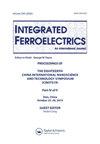Effect of Surface Modification on Corrosion Resistance, Mechanical and Electrical Properties of Epoxy Resin-Based Nanocomposites
IF 0.7
4区 工程技术
Q4 ENGINEERING, ELECTRICAL & ELECTRONIC
引用次数: 0
Abstract
AbstractThe epoxy resin-based nanocomposites have been used to overcome the drawback of epoxy resin such as brittle, low impact resistance, poor stress cracking and poor corrosion resistance in the aggressive environment by incorporating inorganic nanoparticles into the high cross-linked structure of epoxy resin. However, the main problem of these composites is the agglomeration of nanoparticles which influences the worst dispersion in the epoxy matrix and leads to poor properties of the composite. Therefore, this work aims to study the effect of nanoparticle additions, i.e. ZrO2 nanoparticle and SiO2 nanoparticle including waste glass powder (WGP) which is an alternative inorganic filler, on properties of the epoxy resin-based nanocomposite. The particle surface of each filler was also modified with 3-glycidoxypropyltrimethoxysilane (GTPMS) in order to achieve better dispersion in the disk-shaped bulk composites. The chemical property of modified fillers was characterized by Fourier transform infrared spectroscopy (FT-IR). The physical properties, mechanical properties, water absorption and corrosion resistance of all composites are then investigated. The results revealed that the incorporations of ZrO2, SiO2, and WGP with GPTMS surface modification into epoxy resin-based nanocomposite exhibit better performance in mechanical properties, water absorption and corrosion resistance than the unmodified surface of ZrO2, SiO2, and WGP additions. Although, both modified- and unmodified surfaces of fillers for the epoxy resin-based nanocomposites show improvement in all properties compared to the neat epoxy resin but the electrical properties of epoxy resin-based nanocomposites with unmodified fillers and GPTMS-modified fillers do not show a significant effect on any electrical properties.Keywords: Surface modificationGTPMSepoxy resinnanocomposites Disclosure StatementNo potential conflict of interest was reported by the author(s).Additional informationFundingThis work is supported by National Research Council of Thailand (NRCT), Nanotechnology and Material Analytical Instrument Service Unit (NMIS), College of Materials Innovation and Technology and King Mongkut’s Institute of Technology Ladkrabang.表面改性对环氧树脂基纳米复合材料耐蚀性、力学和电性能的影响
摘要环氧树脂基纳米复合材料通过在环氧树脂的高交联结构中掺入无机纳米粒子,克服了环氧树脂易碎、耐冲击性低、应力开裂性差、耐腐蚀性差等缺点。然而,这些复合材料的主要问题是纳米颗粒的团聚,这影响了复合材料在环氧基体中的分散性,导致复合材料性能差。因此,本工作旨在研究纳米颗粒的添加量,即ZrO2纳米颗粒和SiO2纳米颗粒,以及废玻璃粉(WGP)作为一种替代无机填料,对环氧树脂基纳米复合材料性能的影响。采用3-甘氧基丙基三甲氧基硅烷(GTPMS)对各填料的颗粒表面进行改性,使其在圆盘状体状复合材料中具有更好的分散性。用傅里叶变换红外光谱(FT-IR)对改性填料的化学性质进行了表征。研究了复合材料的物理性能、力学性能、吸水性和耐腐蚀性。结果表明,在环氧树脂基纳米复合材料中掺入ZrO2、SiO2和WGP并进行GPTMS表面改性后,其表面的力学性能、吸水性和耐腐蚀性均优于未掺入ZrO2、SiO2和WGP的纳米复合材料。与纯环氧树脂相比,环氧树脂基纳米复合材料的改性和未改性填料表面均表现出各项性能的改善,但未改性填料和gptms改性填料对环氧树脂基纳米复合材料的电学性能没有显著影响。关键词:表面改性环氧树脂纳米复合材料公开声明作者未报告潜在利益冲突。这项工作得到了泰国国家研究委员会(NRCT)、纳米技术和材料分析仪器服务单位(NMIS)、材料创新与技术学院和蒙库特国王拉德克拉邦理工学院的支持。
本文章由计算机程序翻译,如有差异,请以英文原文为准。
求助全文
约1分钟内获得全文
求助全文
来源期刊

Integrated Ferroelectrics
工程技术-工程:电子与电气
CiteScore
1.40
自引率
0.00%
发文量
179
审稿时长
3 months
期刊介绍:
Integrated Ferroelectrics provides an international, interdisciplinary forum for electronic engineers and physicists as well as process and systems engineers, ceramicists, and chemists who are involved in research, design, development, manufacturing and utilization of integrated ferroelectric devices. Such devices unite ferroelectric films and semiconductor integrated circuit chips. The result is a new family of electronic devices, which combine the unique nonvolatile memory, pyroelectric, piezoelectric, photorefractive, radiation-hard, acoustic and/or dielectric properties of ferroelectric materials with the dynamic memory, logic and/or amplification properties and miniaturization and low-cost advantages of semiconductor i.c. technology.
 求助内容:
求助内容: 应助结果提醒方式:
应助结果提醒方式:


